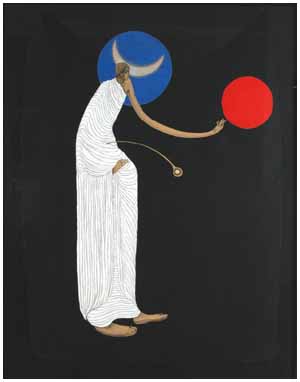| The intensity of Datta Bansode's politically
aware paintings may be traced to his first encounters
with art as a boy in Latur. Bansode's first teacher
was the artist and Buddhist monk Jagtap Sur. Using hardboard
and enamel paints, Sur painted portraits of Buddha,
Gandhi, Nehru, and Shivaji in a vivid, realistic style.
"He was my first guru," says Bansode, "a
good teacher of drawing and painting."
Bansode went on to study art in Pune and Mumbai, taking
inspiration from his conversations with senior artists
Prabhakar Barve and Tuka Jadhab. At the J.J. School
of Art, he became exposed to the contemporary styles
and began experimenting with new techniques of applying
paint to canvas. He describes his works of this early
period as brightly-coloured compositions depicting daily
scenes, including ad hoc still-lifes of his bedroom
and portraits of his friends.
A turning point came in 1992, when Bansode returned
to Latur in the aftermath of a major earthquake. Walking
through the ravaged streets, he glimpsed many women
in mourning for their lost families. The starkness of
their figures touched him, and inspired a change in
his style. "I painted the widows over and over,
and gradually their figures became simplified."
Abandoning bright colors, Bansode began to work with
a palette of chalk-white, beige and charcoal, creating
somber, uncluttered compositions of grieving widows.
His work shifted in focus after the 1998 nuclear bomb
tests in India. Bansode was struck by the irony of the
code phrase - "Buddha's Smile" - used by the
government to refer to the tests. "After all,"
he says, "Buddha's philosophy is one of peace,
and anti-crime." In response, he began his Lord
Buddha series. Bansode explains that "I wanted
to show that Buddha's birth happened here, but we have
forgotten his philosophy." Retaining a neutral
palette, the series draws on the paintings of Ellora
and Ajanta to depict the major events of Buddha's life.
The details of Buddha's figure are inspired by the Mathuran
and Gandhari sculptures of the Buddha.
As influences, Bansode names the work of Tyeb Mehta
and Sunil Das, stressing the importance of the Indian
tradition in his own approach to art.

back |



